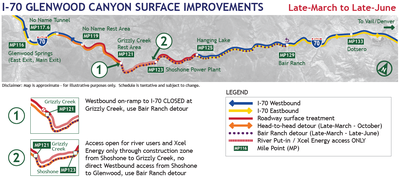Head-to-head detour to begin on I-70 in Glenwood Canyon
Travel Advisory
Garfield County & Eagle County – The Colorado Department of Transportation asks Interstate 70 Glenwood Canyon travelers to plan for additional travel time beginning Thursday, April 2 when the head-to-head detour between Hanging Lake Tunnel (mile point (MP) 125) and No Name Tunnel (MP 117.6) is scheduled to begin, weather permitting. Westbound traffic will be shifted onto the lower, eastbound traffic deck where one lane of traffic will be open in each direction. On Thursday, April 2 motorists should anticipate intermittent stops on I-70 Eastbound and Westbound for crews to install the head-to-head detour.
Significant delays are anticipated through the detour route. “Delay times will vary depending on travel volumes in the canyon. Plan for an additional 30 minutes to your travel time, especially during morning and evening peak hours,” said CDOT Region 3 communications manager, Elise Thatcher.
To help with some of the uncertainty that comes with travel in the Glenwood Canyon, CDOT is piloting new smart work zone signage that will provide live travel time estimates based on real-time traffic volumes. “It’s important for CDOT to provide the best information possible for motorists,” said Michael Goolsby, regional transportation director for northwest Colorado. “This is an innovative approach to providing up-to-the-minute conditions for drivers in a location where cell service and other communications are limited.”
Smart work zone signs are placed in three locations outside Glenwood Canyon: on I-70 Eastbound near Glenwood Springs (MP 116), on I-70 Westbound near Dotsero (MP 133) and on Westbound/Northbound CO-82 near the Glenwood Springs city limits. Usual weekday travel peak hours are when motorists are commuting to and from work, approximately 7 to 10 a.m. and 4 to 7 p.m.
For estimated travel times, motorists can also call or text the project information line at 970-618-5379.
Motorists should use both lanes to the merge point, also called a zipper merge. CDOT asks travelers to be aware of posted speed limits throughout work zones, to keep both fellow motorists and crews safe.
Grizzly Creek (MP 121) and Shoshone (MP 123) Traffic Impacts
Beginning concurrently with the head-to-head detour on Thursday, April 2, the Westbound on-ramp at Grizzly Creek will close for construction access. Westbound motorists departing from Grizzly Creek will use the Eastbound I-70 on-ramp and continue to Bair Ranch (MP 129) for access to Westbound I-70. This traffic pattern is anticipated to be in effect until late-June.

Routes and schedules are subject to change. Motorists are encouraged to sign up for traffic and trail impact updates by contacting public information via email, [email protected], or phone, 970-618-5379.
Stay Informed
To sign up for traffic and trail impact email updates, please contact public information via email, phone or text.
- Project Information (call or text): 970-618-5379
- Email: GlenwoodCanyon2020@
gmail.com - Project Webpage: codot.gov/projects/
GlenwoodCanyon2020 - Travel Conditions: cotrip.org
- See scheduled lane closures.
- Sign up for project and real-time travel alerts.
- Facebook | Twitter
Remember: Slow for the Cone Zone
The following tips are to help you stay safe while traveling through maintenance and construction work zones.
- Do not speed in work zones. Obey the posted speed limits.
- Stay Alert! Expect the unexpected.
- Watch for workers. Drive with caution.
- Don't change lanes unnecessarily.
- Avoid using mobile devices such as phones while driving in work zones.
- Turn on headlights so that workers and other drivers can see you.
- Be especially alert at night while driving in work zones.
- Expect delays, especially during peak travel times.
- Allow ample space between you and the car in front of you.
- Anticipate lane shifts and merge when directed to do so.
- Be patient!
Know Before You Go
Travelers are urged to “know before you go.” Gather information about weather forecasts and anticipated travel impacts and current road conditions prior to hitting the road. CDOT resources include:
- CDOT winter driving tips downloadable flyer: WinterWise Driving Tips
- Road conditions and travel information: www.COtrip.org
- Chain and traction law information: codot.gov/admin/travel/
winter-driving/tractionlaw - Sign up for project or travel alerts: bit.ly/COalerts
- See scheduled lane closures: codot.gov/travel/scheduled-
lane-closures.html - Connect with us on social media: Twitter @coloradodot and Facebook facebook.com/coloradodot
Whole System, Whole Safety
In early 2019, CDOT announced its Whole System — Whole Safety initiative to heighten safety awareness. This initiative takes a systematic, statewide approach to safety combining the benefits of CDOT’s programs that address driving behaviors, our built environment and the organization's operations. The goal is to improve the safety of Colorado’s transportation network by reducing the rate and severity of crashes and improving the safety of all transportation modes. The program has one simple mission—to get everyone home safely.
